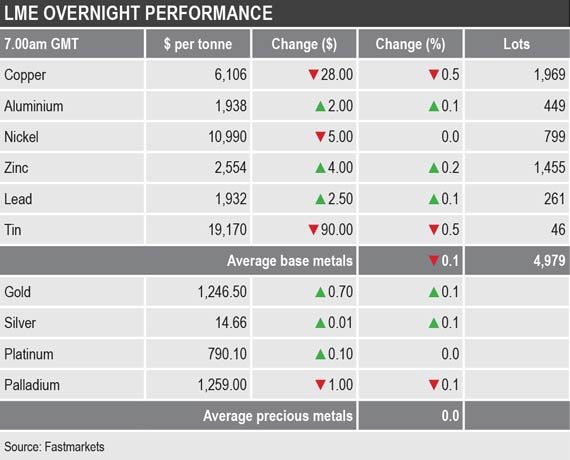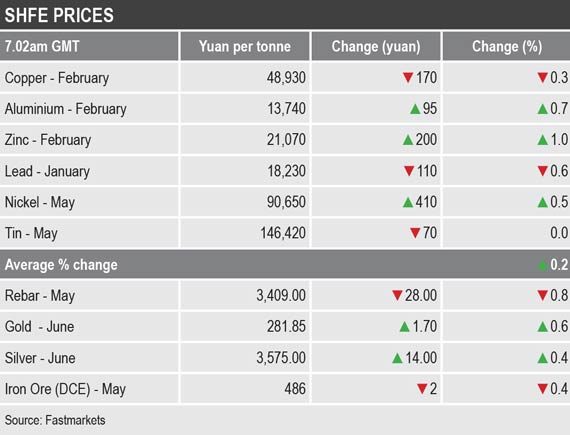The rest were either unchanged or up between 0.1% and 0.2%. Considering the weakness in US equity markets on Monday, it is surprising that the metals have not been under more downward pressure.
Volume across the complex has been above average with 4,968 lots traded as at 7.00am London time.
Precious metals prices were for the most part little changed this morning, this after a firmer tone on Monday. Gold was recently quoted at $1,247 per oz.
In China this morning, the base metals prices on the Shanghai Futures Exchange were mixed; February copper and January prices lead were down by 0.3% and 0.6% respectively, the May tin price was slightly weaker, while the rest were up between 0.5% and 1%. The February copper contract was recently quoted at 48,930 yuan ($7,093) per tonne.
In wider markets, spot Brent crude oil prices were were weaker by 0.37% at $58.54 per barrel. The yield on US 10-year treasuries has weakened again and was recently quoted at 2.8419% after haven asset buying reappeared. The yields on the US 2-year and 5-year treasuries remain slightly inverted at 2.6740% and 2.6701% respectively. The German 10-year bund yield was also weaker at 0.2420%.
Asian equity markets followed western markets lower on Tuesday: the Nikkei (-1.82%), the Kospi (-1.43%), the ASX 200 (-1.22%), the CSI 300 (-1.04%) and the Hang Seng (-1.12%).
This morning’s performance follows a weak performance in western markets on Monday where poor data from the United States spooked the markets; in the US, the Dow Jones Industrial Average closed down by 2.11% at 23,592.98, while in Europe, the Euro Stoxx 50 was down by 0.94% at 3,063.65.
The dollar index has eased, but remains in high ground and was recently quoted at 97.08. The other major currencies we follow are firmer, but remain in low ground: the euro (1.1348), the Australian dollar (0.7187), the yen (112.56) and sterling (1.2636). Indeed the relative strength of the yen suggests a pick-up in haven asset buying.
The yuan is holding up above recent lows and was recently quoted at 6.8997. The emerging market currencies we follow are not showing too much concern, suggesting the weakness being seen is focused on mature markets.
On the economic agenda on Tuesday, there is data on German Ifo business climate along with US releases that includes building permits and housing starts.
The base metals prices are for the most part stuck sideways, with underlying support and overhead resistance keeping the complex rangebound. The longer prices have been rangebound, the more they are looking like wound up springs – when they break-out they are likely to have considerable directional energy. We said last week there may be a race on between whether the trade dispute is resolved before the global economic data deteriorates to the extent that it also becomes a negative factor too – a factor that become more apparent after the release of weak Chinese data on December 14 and weak US data on Monday. In this climate, we expect the widely expected US Federal Open Market Committee rate rise on Wednesday to be accompanied by a dovish statement.
Gold’s rebound ran out of steam last week, but risk-off in other markets is seeing some inflow into gold this week. Given weakness in other markets, combined with political/geopolitical uncertainty that continues to drag on, and weaker government bond yields, it is not so surprising that gold has picked up a tail wind.



